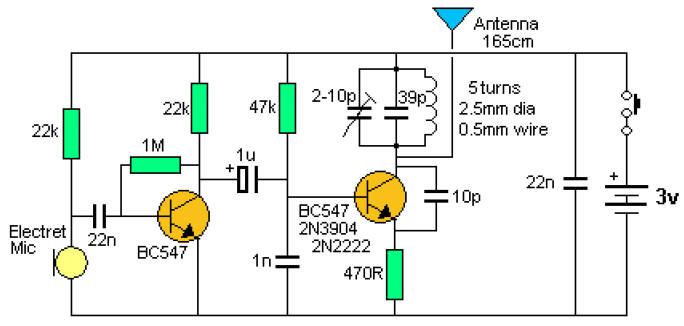
FM 2 TRANSISTOR CIRCUITS
The next progressive step is to add a transistor to give the electret microphone more sensitivity. The electret microphone contains a Field Effect Transistor and you can consider it to be a stage of amplification.
That's why the electret microphone has a very good output. A further stage of amplification will give the bug extremely good sensitivity and you will be able to pick up the sound of a pin dropping on a wooden floor.
Many of the 1 transistor circuits over-drive the microphone and this will create a noise like bacon-and-eggs frying. The microphone's used require a load resistor of 47k for a 6v supply and 22k for a 3v supply.
The voltage across the microphone is about 300mV to 600mV. It will produce an audio waveform of about 2-20mV. Only a very simple self-biasing common-emitter stage is needed for the audio amplifier.
This will give a gain of approx 70 for a 3v supply. The next circuit shows this audio amplifier, added to the previous transmitter circuit.
This circuit is the best design using 2 transistors on a 3v supply. The circuit takes about 7mA and produces a range of about 200 - 400metres.

Five points to note in the circuit above:
1. The tank circuit has a fixed 39p and is adjusted by a 2-10p trimmer. The coil is stretched to get the desired position on the band and the trimmer fine tunes the location.
2. The microphone coupling is a 22n ceramic. This value is sufficient as its capacitive reactance at 3-4kHz is about 4k and the input to the audio stage is fairly high, as noted by the 1M on the base.
3. The 1u between the audio stage and oscillator is needed as the base has a lower impedance as noted by the 47k base-bias resistor.
4. The 22n across the power rails is needed to keep the rails "tight." Its impedance at 100MHz is much less than one ohm and it improves the performance of the oscillator enormously.
5. The coil in the tank circuit is 5 turns of enameled wire with air core. This is much better than a coil made on a PC board and is cheaper than a bought inductor.
The secret to long range is high activity in the oscillator stage. The tank circuit (made up of the coil and capacitors across it) will produce a voltage higher than the supply voltage due to the effect known as "collapsing magnetic field" and this occurs when the coil collapses and passes its reverse voltage to the capacitor.
The antenna is also connected to this point and it receives this high waveform and passes the energy to the atmosphere as electromagnetic radiation.
When the circuit is tightly constructed on a PC board, the frequency will not drift very much if the antenna is touched. This is due to the circuit design and layout as well as the use of large value capacitors in the oscillator. If low value capacitors are used, the effect of your body has a greater effect on changing the frequency.
HAND-HELD MICROPHONE
The following circuit is suitable for a hand -held microphone. It does not have an audio amplifier stage but that makes it ideal as a microphone, to prevent feedback. The output has a buffer stage to keep the oscillator away from the antenna. This gives the project the greatest amount of stability.
To get good audio amplification, and a stable oscillator and the ability to handle the circuit without it drifting, we need 3 transistors.
